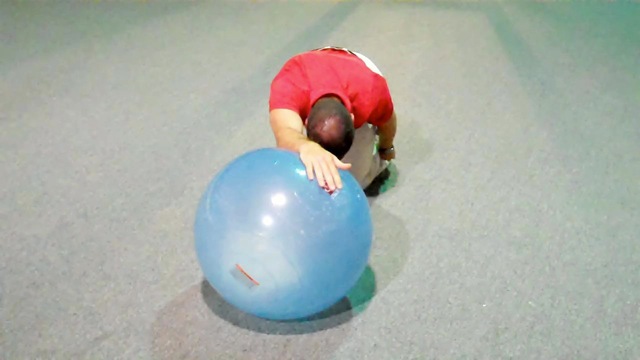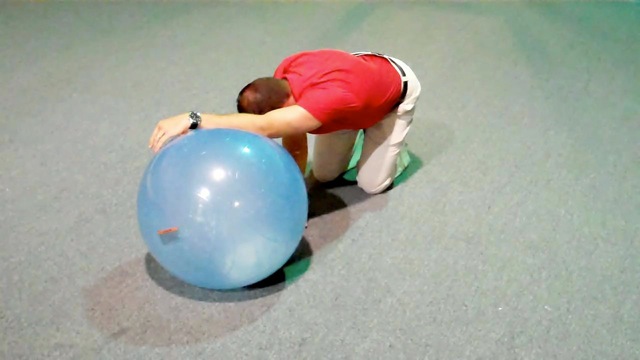
It is common to assess clients with latissimus tightness. This is often manifested as limited shoulder flexion mobility. This diminished range of motion can be particularly detrimental for overhead athletes and when training the Olympic lifts. The following stretches are simple ones and effective for reducing tightness.
Execution:
Begin in kneeling and position the hands/forearms in a prayer position on top of the BOSU Ballast Ball. Next slowly allow the head and trunk to lower down (meanwhile the BOSU Ballast Ball will also slowly roll forward) easing into a sustained stretch. Hold for 20-30 seconds and repeat twice. You may also opt for a more active isolated approach by moving toward end range and actively contracting the anterior deltoids 2-3 seconds to flex the shoulders at end range. Release and return to the start position and repeat 10 times.
 |  |
 |  |
Application:
This stretch is useful for maximizing shoulder flexion and mobility. It may be necessary to use soft tissue mobilization prior to the stretch if trigger points are present. I use it in rehab and in shoulder mobility programs for my athletes. Maximizing shoulder mobility (flexion) will help reduce excessive extension and/or rotation in the spine that appears as compensatory motion in order to complete overhead activities such as snatches, overhead squats, throwing and serving motions.
I prefer the BOSU Ballast Ball because it offers adequate stability with its design yet natural movement that the client can use to carefully control motion and attain an ideal stretch. Small graded progressions can be made easily based with the ability to roll and adjust the position of the BOSU Ballast Ball during the movement.
Precautions:
Use caution with clients experiencing rotator cuff pathology, tendonitis, arhtritis, labral pathology, or shoulder instability. Forcing the shoulder into end range elevation can cause shoulder impingement. Any pain felt in the shoulder as opposed to a stretch along the latissimus would be an indication to stop the exercise and refer the client for further evaluation by a medical professional.
Brian Schiff, PT, OCS, CSCS, is a licensed physical therapist, respected author and fitness professional. Currently, he serves as the supervisor at the Athletic Performance Center in Raleigh, NC. Brian presents nationally at several professional conferences and seminars on injury prevention, rehab and sport-specific training. For more cutting edge training information, subscribe to his monthly Training & Sports Medicine Update at www.BrianSchiff.com.

















